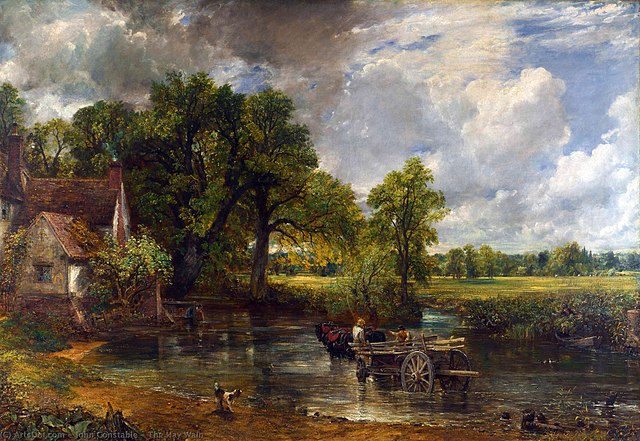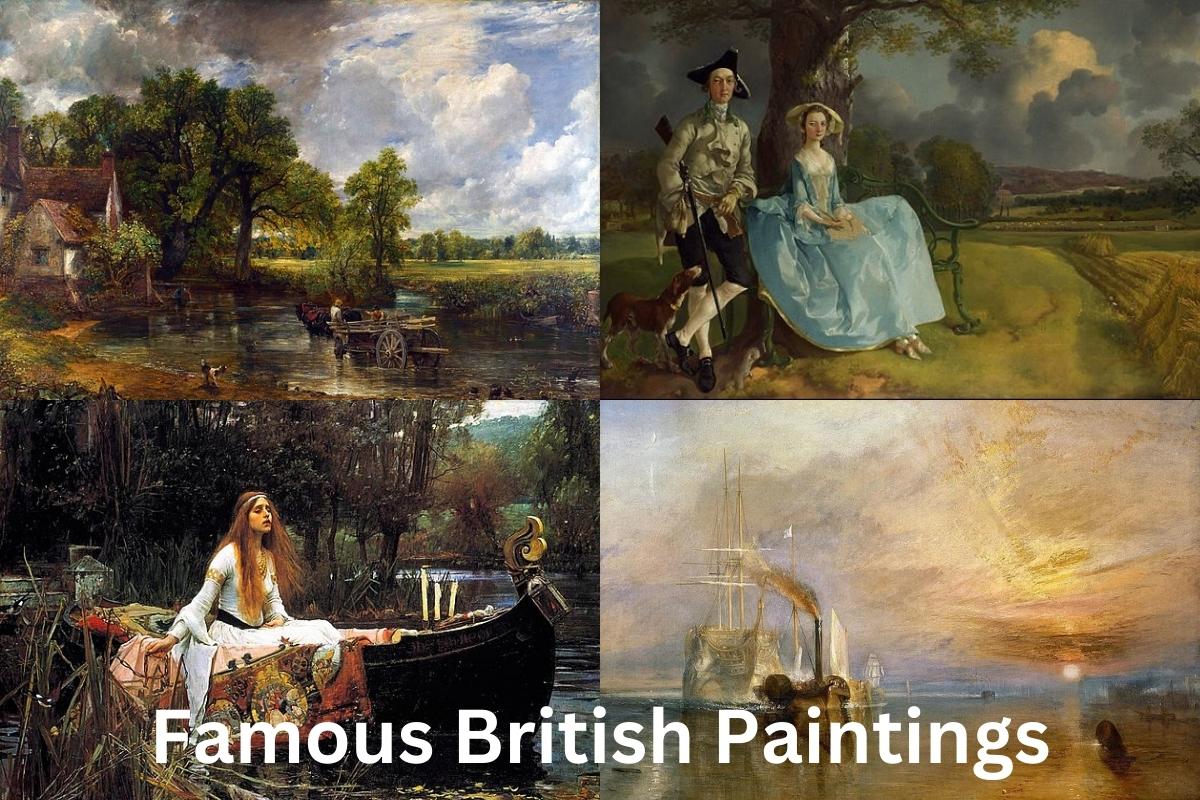The term British Paintings will usually refer to art produced in the United Kingdom since the establishment of the Kingdom of Great Britain in 1707. This includes both English and Scottish art as well as Welsh art, and is considered a part of Western art history.
In the eighteenth century, British art, particularly portraiture and landscape painting, began to recapture the preeminent position England had held in European art during the middle ages.
Many different artists contributed to the Romantic era, including as William Blake, J. M. W. Turner, John Constable, and Samuel Palmer.
The Victorian era saw an unprecedented explosion in the number and variety of artistic production. There has been a shift in critical attention away from much Victorian art and toward the Pre-Raphaelites and the inventive movements of the late 18th century.
While the United Kingdom did not make a significant impact on early Modernist art, it has subsequently become a major hub of the increasingly globalized art world, thanks in large part to the contributions of British artists, particularly those working in the figurative tradition, since World War II.
Famous British Paintings
1. The Fighting Temeraire – J. M. W. Turner

Turner’s oil painting The Fighting Temeraire (full title: The Fighting Temeraire, tugged to her last berth to be broken up) was finished in 1838 and shown at the Royal Academy in 1839.
The picture shows the 98-gun HMS Temeraire, one of the last second-rate ships of the line to take part in the Battle of Trafalgar, being pulled up the Thames by a paddle-wheel steam tug in 1838, on its way to its last berth at Rotherhithe to be broken up for scrap.
In 1851, the Turner left the painting to the country. It is now on display at the National Gallery in London. It was chosen as the best piece of art in the country and put on the new £20 note.
Also Read: Famous Paintings in London
Turner was at the top of his career when he made this piece. For 40 years, he had shown his work at the Royal Academy in London.
He was known for his moody paintings in which he looked at the weather, the sea, and how light affects things.
He spent most of his time near the River Thames and painted many watercolor and oil paintings of ships and waterside scenes. Turner often made small sketches that helped him plan his paintings, which he then turned into finished works in his workshop.
2. The Lady of Shalott – John William Waterhouse

The Lady of Shalott is a painting by English artist John William Waterhouse from 1888. It shows the conclusion of the 1832 poem of the same name by Alfred, Lord Tennyson.
This figure was portrayed by Waterhouse in 1888, 1894, and 1915. Despite the fact that Waterhouse was painting decades after the Pre-Raphaelite Brotherhood disbanded during his youth, he inherited much of their style in this, one of his most recognized works.
Sir Henry Tate presented the Lady of Shalott to the public in 1894, and it is currently on display in room 1840 at Tate Britain in London.
The Lady of Shalott, an 1888 oil-on-canvas painting, is one of John William Waterhouse’s most recognized works. This figure was portrayed by Waterhouse in 1888, 1894, and 1915.
It depicts a scene from Tennyson’s poem in which the poet describes the plight and predicament of a young woman, loosely based on Elaine of Astolat from medieval Arthurian legend, who yearned with unrequited love for Sir Lancelot, who was isolated in a tower near King Arthur’s Camelot under an unknown curse.
3. Mr and Mrs Clark and Percy – David Hockney

Hockney is particularly well-known for his series of enormous double portraits, which often depict an impassioned man and woman.
Hockney is well known for his bright, sunny depictions of life in Southern California, thus Mr. and Mrs. Clark and Percy stood in stark contrast to those.
However, this painting depicts a fairly gloomy scenario, with the couple seemingly taking in the scenery from the comfort of their home’s dismal interior.
The two humans in the picture, however, seem unable to let go of the shadows, while their cat, Percy, appears to be the only one in the shot who is completely enamored with the natural world.
Numerous art experts and commentators have said that Hockney’s intention in creating this piece was to spotlight the bond between Mr. and Mrs. Clark.
4. Ophelia – John Everett Millais

Ophelia, painted by Sir John Everett Millais between 1851 and 1852, is on display at London’s Tate Britain. Ophelia, a character in Shakespeare’s Hamlet, croons as she drowns in a river in Denmark.
It has been considered one of the most important works of the mid-nineteenth century because to its beauty, precision, and influence on artists such as John William Waterhouse, Salvador Dal, Peter Blake, and Ed Russa.
The image shows Ophelia singing while she floats down a river. Queen Gertrude’s monologue in Act IV, Scene VII of Hamlet depicts the action.
It tells the story of a woman who spends her entire life pining for joy, only to come to terms with her fate at the end of her life. Many works by pre-Raphaelite artists feature helpless ladies.
Millais was admired for his commitment to realism, his ability to capture natural light, and his use of bold color.
5. The Hay Wain – John Constable

John Constable, a painter from the 19th century, is widely considered to be one of the best nature painters of all time.
Constable, an Englishman who was born in 1776, rose to prominence as one of the period’s most acclaimed Romanticist artists. Trees and expansive European landscapes were frequent subjects of his works.
The Hay Wain, one of Constable’s most famous paintings, was finished in 1821. The farmer in the painting is seen crossing the River Stour with his horse-drawn wagon in the rural areas straddling the border between Suffolk and Essex.
Constable accurately depicted the peaceful existence of English farmers by painting their big trees that lined the river.
6. Girl with Balloon – Bansky

Graffiti artist Banksy began a series of stencil murals in London in 2002 called Girl with Balloon (also known as Balloon Girl or Girl and Balloon), depicting a little girl reaching out for a red heart-shaped balloon that is being swept away by the wind.
Street murals in Shoreditch and on the South Bank near the Waterloo Bridge and other murals were located around London, but none are now visible.
Banksy has used variations of this artwork to promote social initiatives on a number of occasions, including in 2005 in reference to the West Bank barrier, in 2014 in reference to the Syrian refugee crisis, and most recently in 2017 in reference to the UK election. Girl with Balloon was voted the UK’s favorite piece of art by Samsung in 2017.
In 2018, at the time of an auction, a framed replica of the work mysteriously shredded itself thanks to a secret mechanical component hidden by Banksy.
Banksy admitted guilt for the destruction and retitled his work “Love is in the Bin” to reflect the change. As Sotheby’s put it, it was “the first work in history ever made during a live auction.”
7. The Ambassadors – Hans Holbein the Younger

In 1533, Hans Holbein the Younger created The Ambassadors. It was created in the same year Elizabeth I was born, during the Tudor period, and was also known as Jean de Dinteville and Georges de Selve.
According to Franny Moyle, Elizabeth’s mother, Anne Boleyn, the then-Queen of England, may have commissioned the painting as a gift for the ambassador on the picture’s left, Jean de Dinteville.
In addition to the double portrait, the picture features a still life comprised of multiple exquisitely rendered objects, the significance of which is the topic of intense debate. It contains a well-known artistic example of anamorphosis. The Ambassadors has been part of the collection of London’s National Gallery since its acquisition in 1890.
The twisted skull in the composition’s lower center is the most recognizable and well-known of Holbein’s symbols in the piece.
The skull, represented in anamorphic perspective, is intended to be a visual dilemma, since the viewer must approach the painting from a high position on the right or a low position on the left in order to recognize the shape as an accurate representation of a human skull.
Although the skull is obviously a vanitas or memento mori, it is unclear why Holbein placed it so prominently in this painting.
8. Mr and Mrs Andrews – Thomas Gainsborough

The portrait of Mr. and Mrs. Andrews, painted by Thomas Gainsborough in around 1750 and now housed in the National Gallery in London, is an oil on canvas.
The painting, which was kept in the family of the sitters until 1960 and was relatively unknown until it was featured in an exhibition in Ipswich in 1927, where it was frequently solicited for other shows in Britain and abroad and received critical acclaim for its beauty and freshness.
Its iconic reputation was cemented in the years following World War II, and in 1953, it was selected as one of four paintings to represent British art in an exhibition honoring the coronation of Queen Elizabeth II in Paris.
As a symbol of the paternalistic and capitalist society of 18th-century England, the picture soon came under fire from critics, but it has since become a fan favorite.
9. Whistlejacket – George Stubbs

George Stubbs painted what is possibly the most famous horse portrait in history. Stubbs, unlike the vast majority of other painters, taught himself how to paint by studying the works of other famous artists.
Throughout the 18th century, the British artist produced numerous paintings of horses in a wide variety of settings and behaviors, demonstrating his deep interest in the subject.
Whistlejacket, painted by Stubbs in 1762, is widely regarded as one of the greatest examples of horse art in the history of Western art. The Marquess of Rockingham’s favorite racehorse posed for the painting.
The painting was created on a gigantic, practically life-size canvas with a solid background, drawing the viewer’s attention solely to the legendary racehorse at the center of the composition.
10. Three Studies for Figures at the Base of a Crucifixion – Francis Bacon

Irish-born British artist Francis Bacon painted a triptych in 1944 titled Three Studies for Figures at the Base of a Crucifixion.
The canvases are inspired by Aeschylus’s Oresteia, namely the Eumenides, who are three writhing humanoid figures against a flat, burnt orange background.
It took only two weeks to complete using oil paint and pastel on Sundeala fibre board. Bacon had already examined Picasso’s biomorphs, interpreted the Crucifixion, and shown the Greek Furies, all of which are summed together in this triptych.
Bacon had planned to paint a massive crucifixion scene with the figures gathered around the base of the cross, but he never finished the work.

